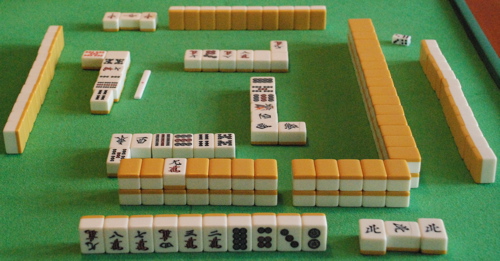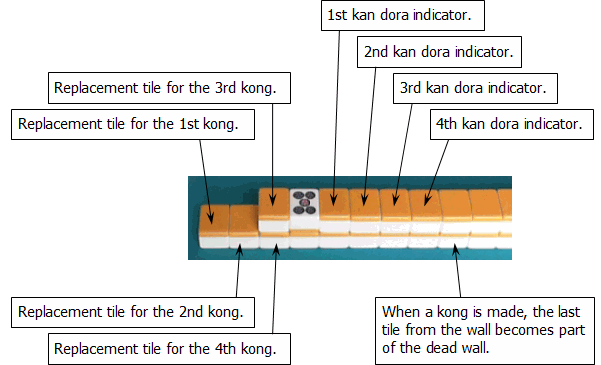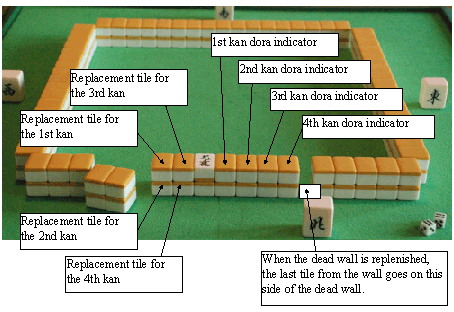5.4Making a group
• The most recent discard can be claimed by any of the other players, provided they can complete a winning hand, a pung or a kong. A claimed pung or kong may result in players losing their turn, as play continues from the claiming player, not from the discarding player. • The player about to begin his turn can claim the most recent discard for a chow. If the player doesn’t want to claim the discard, he begins his turn by picking the next tile from the wall. When claiming a tile for a chow, pung or kong, the player first clearly calls “chii”, “pon” or “kan” respectively. Secondly, the player reveals the matching tiles from his hand. And thirdly, he discards a tile from his hand and takes the tile called for. For the third step the order of the two actions is not important: the player can take the claimed tile first and then discard, or the other way round. Errors in the order above when claiming tiles should be pointed out to the player, but not penalized. The player should take the claimed tile before the next two players have made a discard. Failing to take the claimed tile in a timely manner results in a dead hand, since the player will have a false group. Swap-calling (kuikae) is not allowed. It is forbidden to: - Call a tile and immediately discard the same tile. (E.g.: calling  , melding    , and discarding  .) - Call a tile for a chow and immediately discard the tile from the other side of the chow. (E.g.: calling  , melding    , and discarding  .) | 3.3.1The most recent discard
The most recent discard can be claimed by any of the other players, provided they can complete a mahjong hand, a kong or a pung. A claimed kong or pung may result in players losing their turn, as play continues from the claiming player, not from the discarding player. If a player claims a tile for winning, any concurrent claim for kong, pung or chow is ignored. It is possible for several players to win on the same discard. The player about to begin his turn can claim the most recent discard for a chow. If the player doesn’t want to claim the discard, he begins his turn by picking a tile from the wall.  Claiming a tile for winning takes precedence over any other claim. Claiming a tile for kong or pung takes precedence over a claim for chow, but should occur within three seconds. A player who has claimed a tile for winning cannot change his claim. If the most recent discard is claimed after the next player has picked a tile, but within three seconds after the discard, the picked tile is replaced in the wall. |
5.4.1Precedence and timing for declarations
The last discarded tile can be claimed for a chow, pung or kong until the next player draws. But it can be claimed for a win until the next player discards.
Claiming a tile to win takes precedence over any other claim. When several players declare a win on the same discarded tile, the player closer to the discarder, according to the turn order, takes precedence.
If no one declares a win, the first call for a chow, pung or kong takes precedence. If the calls are simultaneous, or if it's not clear which one was first, then claims for a pung or kong take precedence over claims for a chow.
Players are not limited in time to play, but they are expected to play at a reasonable pace. A player drawing too fast for the other players to have time to call, or repeatedly taking an overlong time, can be penalized for obstruction at the referee discretion.
If a player draws too fast for the other players to have time to call, the call is still valid and the drawn tile must be put back into the wall.
By courtesy, East player is expected to wait until each player has sorted his hand before making his first discard. | |
5.4.2Melded chow
A tile can only be claimed for a chow by the player to the right of the discarder. Claiming the last discarded tile for a chow is done by clearly saying “chii” and placing the tile face-up along with the two tiles from the hand that complete the group. | 3.3.4Melded chow
A tile can only be claimed for a chow from the player on the left. Claiming the last discarded tile for a chow is done by clearly calling “chow” or “chi”, placing the tile face-up along with the two tiles from the hand that complete the set. |
5.4.3Concealed chow
A player can make a chow with only self-drawn tiles. He does not declare it. | |
5.4.4Melded pung
Claiming the last discarded tile for a pung is done by clearly saying “pon” and placing the tile face-up along with the two matching tiles from the hand. | 3.3.3Melded pung
Claiming the last discarded tile for a pung is done by clearly calling “pung” or “pon” and placing the tile face-up along with the two matching tiles from the hand. |
5.4.5Concealed pung
A player can make a pung with only self-drawn tiles. He does not declare it. | |
5.4.6Big melded kong
Claiming the last discarded tile for a melded kong is done by clearly saying “kan” and placing the tile face-up along with the three matching tiles from the hand. After revealing a new kan dora, the player takes a replacement tile from the dead wall and continues his turn as if he had drawn a tile from the wall. The dead wall always comprises 14 tiles, so after a kong is made the dead wall is replenished with the last tile of the live wall.  | 3.3.2Melded kong
Claiming the last discarded tile for a melded kong is done by clearly calling “kong” or “kan”, placing the tile face-up along with the three matching tiles from the hand. After revealing a new kan dora, the player takes a replacement tile from the dead wall and continues his turn as if he’d drawn a tile from the wall.
The dead wall always comprises 14 tiles, so after a kong the dead wall is replenished with the last tile of the wall. |
5.4.7Small melded kong
A melded pung may be extended to a melded kong in a player’s turn after the player has taken a tile from the wall (as a normal draw or as a replacement tile), i.e. not in a turn where a tile was claimed for making a chow or pung. The player must say “kan” clearly, place the fourth tile by the rotated tile of the pung, allow a reasonable time for other players' winning declarations, and then reveal a kan dora indicator and take a replacement tile. The dead wall is replenished with the last tile of the live wall. | 3.3.7Extending a melded pung to a kong
A melded pung may be extended to a melded kong in a player’s turn after the player has taken a tile from the wall or a replacement tile, i.e. not in a turn where a tile was claimed for chow or pung. The player must call “kong” or “kan” clearly, place the fourth tile by the rotated tile of the pung, allow 3 seconds for mahjong declarations and then reveal a kan dora and take a replacement tile. The dead wall is replenished with the last tile of the wall. |
5.4.8Concealed kong
A concealed kong may be declared in a player’s turn after the player has taken a tile from the wall (as a normal draw or as a replacement tile), i.e. not in a turn where a tile was claimed for a chow or a pung. The player must say “kan” clearly, reveal the four tiles of the kong, then turn the two outside tiles face-down, reveal a kan dora and then take a replacement tile. The dead wall is replenished with the last tile of the live wall.
It's allowed to turn the two middle tiles face-down instead of the two outside tiles.
A player still has a concealed hand after declaring a concealed kong, if the player has no open groups.
A concealed kong cannot be robbed, except to win on the Thirteen Orphans yaku.
Note that four identical tiles only make a kong if they are declared as being a kong. | 3.3.8Concealed kong
A concealed kong may be declared in a player’s turn after the player has taken a tile from the wall or a replacement tile, i.e. not in a turn where a tile was claimed for chow or pung. The player must call “kong” or “kan” clearly, reveal the four tiles of the kong, then turn the two middle tiles face-down, reveal a kan dora and take a replacement tile. The dead wall is replenished with the last tile of the wall.
A player still has a concealed hand after declaring a concealed kong, if the player has no open sets.
A concealed kong cannot be robbed, except to win on Thirteen Orphans.
Note that four identical tiles only make up a kong, if a concealed kong is declared. |
5.4.9Fourth kong
Only four kongs can be declared per hand. When the fourth kong is made the game continues, but no further kong may be declared. Under no circumstance can a fifth kong be made. | 3.3.9Fourth kong
If no-one wins on the discard after the fourth kong, the hand ends in abortive draw, except in the case where it’s the same player who has all four kongs, in which case playing continues, but no further kongs may be declared. Under no circumstance can a fifth kong be made. |
5.4.10Displaying groups
| 3.3.5Displaying sets
|
 , melding
, melding 

 , and discarding
, and discarding  .)
.) , melding
, melding 

 , and discarding
, and discarding  .)
.)












